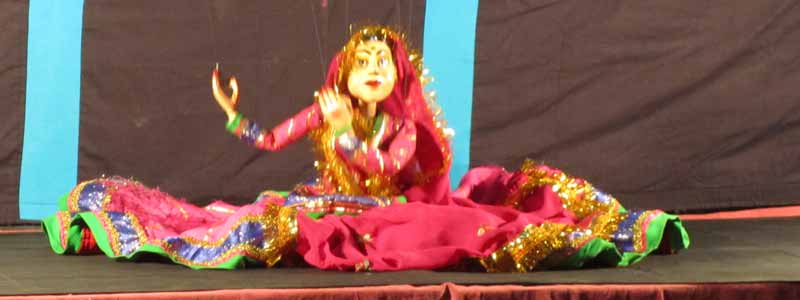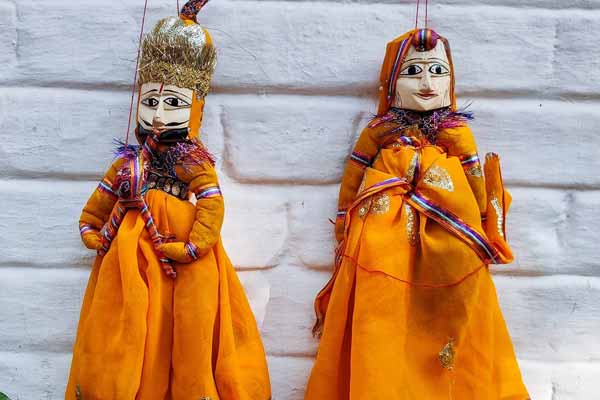Kathputli Dance Rajasthan are a type of puppets. Rajasthan is famous for its puppet-playing tradition. String puppets or Kathputli dance in Rajasthan is an old tradition. In this dance the puppeteer uses balladsto narrate the stories. These storied or tales of romance and chivalry are told with movements of string puppets. In olden days, puppeteers used to travel from place to place through various villages to entertain people. Through puppets, the puppeteer tells the stories of legendary heroes or historic events are narrated through it.
Different types of puppets or Kathputlis are used for popular puppet shows that include Glove Puppets, String Puppets, Rod Puppets and Shadow Puppets. Puppetry or Kathputli Dance Rajasthan holds an important place in traditional entertainment of people. Stories from mythology and legends are told through puppets in Rajasthan. So, with entertainment they spread awareness among the citizens.

What is Kathputli Dance?
Rajasthan Kathputli dance is world famous and well known as Puppetry dance. It is the old tradition of stories from mythology and legends are told through puppets in Rajasthan. String puppetry is very much famous in Rajasthan. Tradition of Kathputli Dance Rajasthan is based on folk tales and stories. Scholars believe that folk tales convey the lifestyle of ancient Rajasthani tribal people and Kathputli art might have originated from present day Nagaur and surrounding areas.

History of Kathputli Dance
According to historians, this art form of Rajasthan is more than thousands years old. It is believed that around 1500 years ago, the Bhat community of Rajasthan started the use of Kathputli as string marionette art. The tradition of Kathputli Dance Rajasthan is based on various folk tales and stories. The scholars are of the opinion that folk tales convey the lifestyle of ancient Rajasthani tribal people and Kathputli art might have originated from present day Nagaur and surrounding areas.
It is said that the Kings and nobles of Kathputli Dance Rajasthan were admirer of Art and Craft. They encouraged and supported the craftsmen in activities ranging from wood and marble carving to weaving, pottery and painting. They would look after the artists and craftsmen in return for the artists singing praises of the patrons’ ancestors.
Performance of Kathputli Dance
Kathputli Dance Rajasthan, For a performance, a small stage is set where puppeteers show puppetry and narrate the story. In the performance, music or ballad plays an important role as the entire performance is based upon the ballad. Sometimes, the puppeteer makes use of various sound effects to achieve the reality impact and give a quality entertainment. The puppeteer shows all his skills to make puppets dance to his tunes. The Kathputli Dance Rajasthan are fixed on stage; in fact they are strung on the stage for the performance. It recounts historic anecdotes, replay tales of love, and include much screeching and high-pitched sound as the puppet twirl and move frenetically at the time of performance.
In olden days, the puppeteers used to travel from place to place through various villages to entertain people. Through puppets, the puppeteer narrated the stories of legendary heroes or historic events. Thus, along with the entertainment they also used to spread awareness among the citizens. Different types of puppets or Kathputlis are used for popular puppet shows that include Glove Puppets, String Puppets, Rod Puppets and Shadow Puppets.
Performance Kathputli Dance
Kathputli Dance Rajasthan is performed during fairs and festive occasions. For a performance, a small stage is set where the puppeteers would show puppetry and narrate the stories. Music or ballads form an integral part of Kathputli Rajasthan as the entire performance is based on the ballad. Sometimes, the puppeteer accompanies the ballads with various sound effects to give the show a greater impact.
These Puppet dances are based on well-known legends and are performed by skillful puppeteers. Displaying his skill in making the puppets’ act and dance, the puppeteer is accompanied by a woman, usually his wife, who plays the dholak, or drum and sings the narrative song. For the performance, a small stage is set where puppeteers show puppetry and narrate the story. During Kathputli dance, tales of romance and courage are told with movements of string puppets.
In the performance, music or narrative song plays a vital role as the whole presentation is based upon the narrative song. Sometimes, the puppeteer makes use of a variety of sound effects to accomplish the reality impact and to give a quality entertainment. The puppeteer shows all his skills and talent to make puppets dance on his tunes. It recounts historic stories, replay tales of love, and include high-pitched sound as the Kathputli Dance Rajasthan twirl and move excitedly at the time of performance. .
In ancient days, puppeteers were known to travel across vast regions through a variety of villages in order to amuse people The puppet shows also tackle some problems like the poverty, unemployment, illiteracy, dowry system, women’s empowerment, and cleanliness. Thus these shows used to spread awareness about the social problems and the ways to overcome them.
